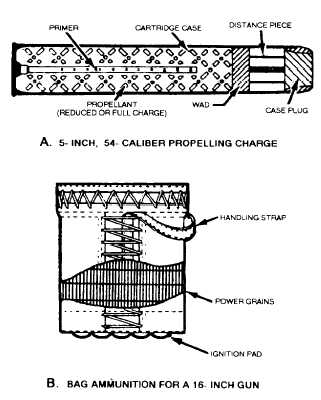| |
expelling charge forces out the base and the illuminating
assembly, and ignites the star or candle.
VARIABLE TIME NONFRAGMENTING
(VT-NONFRAG).— VT-NONFRAG
projectiles
(fig. 6-3, view F) are loaded to avoid rupturing the body
and spreading fragments when the fuze functions;
however, sometimes the projectile ogive breaks up into
low-velocity fragments. They are designed for use in
antiaircraft target practice, particularly against
expensive drone targets, for observing the results of
firing without frequent loss of the drones. These
projectiles have fillers of epsom salts or other inert
material to give the projectile the desired weight. A
color-burst unit, consisting of pellets of black powder
and a pyrotechnic mixture, is placed in a cavity drilled
in the center of the inert filler. The color burst is ignited
through the action of the nose fuze and the black-powder
pellets. The color-burst unit may be one of several colors
that exits through the fuze cavity and ruptured projectile.
PROPELLING CHARGES
Propelling charges are mixtures of explosives
designed to propel projectiles from the gun to the target.
In fixed ammunition, the propelling charge and
projectile are assembled together in a case and handled
as one unit; the principal component parts are the brass
or steel cartridge case, the primer, and a smokeless
powder, the propelling charge. In the separated
ammunition, the propelling charges and projectile are
assembled separately; they are stored and handled as
separate units until they are loaded into the gun. The
propelling charge of the separated ammunition round
consists of the propellant primer, details, and closure
plug assembled into the metal case. The propelling
charges of separate loading ammunition are made up in
sections (bag charges) separate from the projectile and
primer. Propelling charges for all calibers of
ammunition have some common features. There are two
basic categories into which these features can be
grouped: case ammunition and bag charges. Saluting,
reduced, and clearing charges have components that are
the same as case ammunition, so they are included with
case ammunition.
Case Ammunition
Propelling charges for small- and medium-caliber
guns are assembled with primer and powder enclosed in
a brass or steel container, called a cartridge case
(fig. 6-4, view A). Assembly of the entire charge in a
single, rigid, protective case increases the ease and
Figure 6-4.–Propelling charges.
rapidity of loading and reduces the danger of flarebacks.
Also, the case prevents the escape of gases toward the
breech of the gun; it expands from the heat and pressure
of the burning powder and forms a tight seal against the
chamber.
Reduced Charge
A reduced charge is one in which less than the
service load of powder is placed in the cartridge case.
Reduced charges may be used in target practice, to
decrease the wear on the gun.
Clearing Charge
When a round fails to seat fully upon being rammed
into the gun chamber, thus preventing closure of the
breech, or when the propelling charge fails to function,
the projectile may be fired by extracting the full-sized
case and loading a shorter clearing charge.
Saluting Charge
Saluting charges are charges used when firing a gun
to render honors. Since no projectile is involved in such
firing, the charge consists of a cartridge case containing
a black powder load and a primer. The ships normally
employ 40-mm or 3-inch guns for saluting. Saluting
6-6
|

